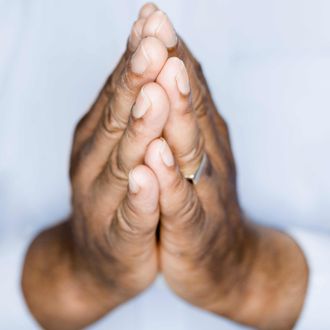
Humans are naturally groupish, so people from diverse backgrounds often do not naturally mesh together. This a challenge for the leaders of diverse groups, and a worthwhile one to tackle given the benefits that can accrue from having a wide variety of viewpoints on hand. A new study in the American Sociological Review suggests a very old-fashioned solution: prayer.
Prayer, argue the trio of researchers from UConn, Duke, and the University of New Mexico, can serve as a useful “bridging cultural practice” that increases group cohesion. Drawing both on ethnographic observations of an interfaith group called, well, Interfaith, and national-level data, the researchers argue that “a coalition’s prayer practices are associated with its objective level of racial and socioeconomic diversity and its subjective perception of challenges arising from such diversity.”
They explain what it was like to sit in on Interfaith events:Among the diverse gatherings observed, all but one included some kind of prayer, and more than half included multiple prayers offered by clergy representing different faith traditions and often delivered in different languages—most commonly English and Spanish, but also occasionally Creole, Russian, Hebrew, or Arabic. Inviting multiple clergy to pray demonstrated the organization’s inclusivity and pulled diverse participants beyond their differences into a partially shared identity as members of this diverse faith community.
Bridging efforts at diverse events were not limited to arranging for multiple and accessible prayers. The content and form of the
prayers also performed bridging work. Specifically, we observed two kinds of prayer content and two prayer forms that were used
to emphasize the qualities that Interfaith’s members share as people of faith, while downplaying or celebrating their differences.
These prayers were also used to underscore the potential inclusivity of this identity category to all participants, regardless of their
religion, race, ethnicity, or class. At times, these contents and forms occurred in combination, illustrating that a single prayer could
perform bridging work on multiple levels.
As the researchers explain, it’s impossible to know the direction of causality here — that is, it may simply be that “[prayer] practices may … attract a more diverse membership to a coalition,” rather than that prayer helps forge community within that coalition. But, they point out, the types of prayer used in the diverse groups they studied tended to take on certain unity-building characteristics that were rarely present in homogeneous groups’ prayers practices, suggesting that prayer did play an important role.
I know a lot of people who are staunch nonbelievers — and I am in this camp myself — are squicked out by any notion of prayer being a useful thing, and would probably not be happy if a group in which they were a member had a few minutes reserved for communal prayer. But it’s worth keeping in mind that (1) this study doesn’t really have anything to do with church-vs.-state issues; and (2) like it or not and despite many other indicators of rising secularism, most Americans still pray daily. So given how difficult — and, in many cases, important — it is to instill in a diverse group a sense of unity and shared purpose, these findings could prove very useful.




